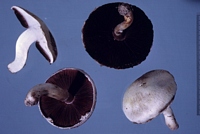|
 Agaricus campestris Agaricus campestris
SynonymsPsalliota campestris
BiostatusPresent in region - Exotic
Images (click to enlarge)
Caption: Agaricus campestris
Owner: Herb. PDD |
Article: Dingley, J.M. (1969). Records of plant diseases in New Zealand. New Zealand Department of Scientific and Industrial Research, Bulletin 192: 298 p. Wellington:.
Notes: Arnold and Brien (1961) recorded "fairy rings" on greens and fairways of golf courses
caused by mycelium of Agaricus campestris smothering grass roots and killing the plants.
it is of minor economic importance.
Article: Massee, G.E. (1899) [1898]. The fungus flora of New Zealand. Transactions and Proceedings of the New Zealand Institute 31: 282–349 Wellington:.
Description: Pileus globose, then expanding until plano-convex, dry, silky, floccose, or broken up into
squamules, whitish, sometimes tinged brown, 6-15 cm. broad; flesh thick at the disc, margin
thinner, becoming reddish-brown when cut, as does also that of the stem; gills free, but close
to the stem, pale-pink, then flesh-colour, finally blackish-brown, inclined to deliquesce at
maturity; spores 7-9 x 6 µ; stem -12 cm. long, stout, subcylindrical, white, stuffed; ring
median on the stem, persistent, more or less torn.
Habitat: In pastures, &c.
Distribution: Northern Island, New Zealand. A cosmopolitan species.
Notes: Edible. Known as the " mushroom " in Britain. (See note under A. arvensis).
Article: Horak, E. (1971). A contribution towards the revision of the Agaricales (Fungi) from New Zealand. New Zealand Journal of Botany 9(3): 403-462 (http://www.rsnz.org/publish/abstracts.php).
Notes: Agaricus campestris (Linne) (1,16) = Agaricus campester Fries. Material:
COLENSO, New Zealand. Apparently introduced like other coprophilous fungi.
|